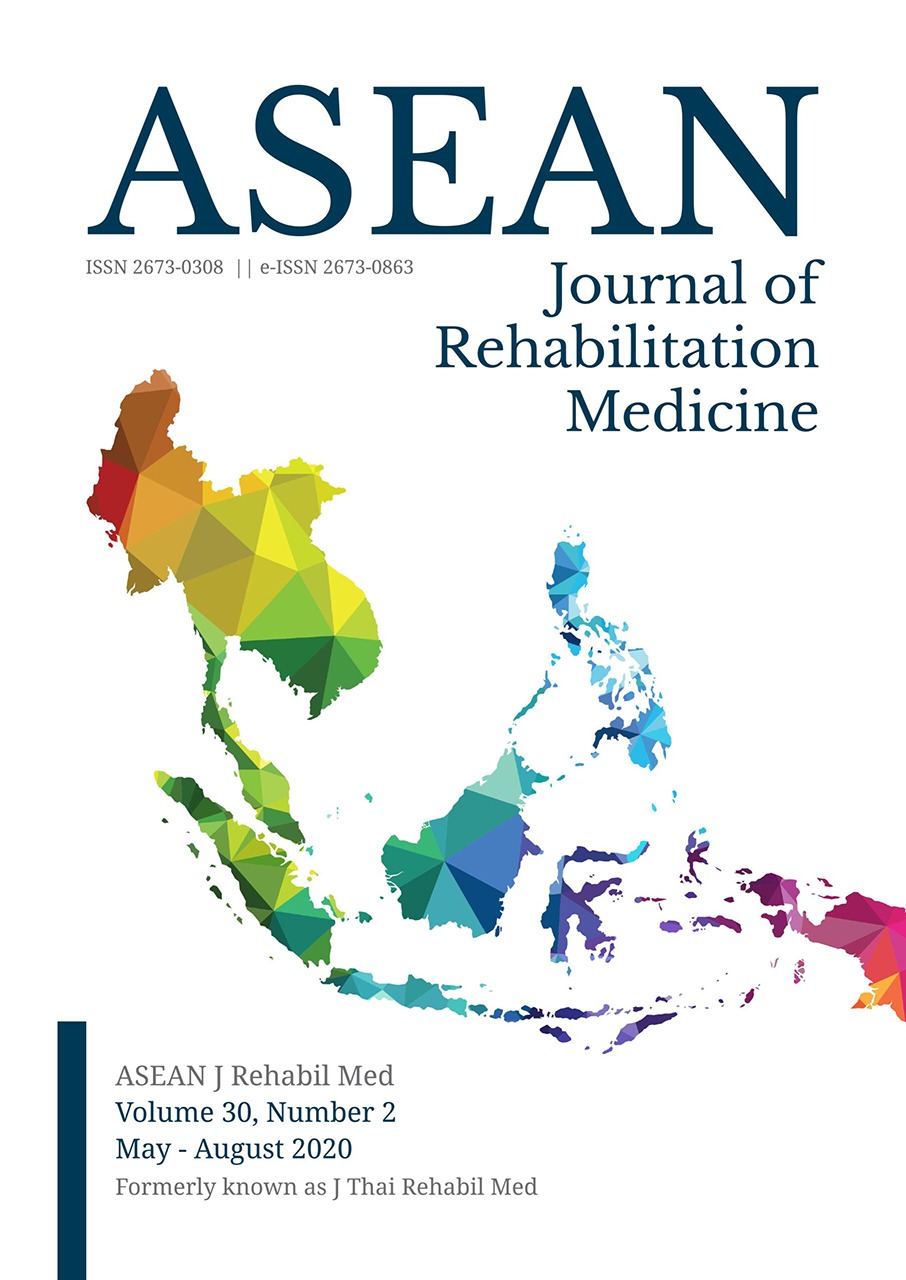Food and Liquid Consistency Modification for Safe Swallowing in Elderly with Dysphagia Risk
Keywords:
deglutition disorder, oropharyngeal dysphagia, foodAbstract
Objectives: This study aimed to evaluate the effect of food and liquid consistency modification on swallowing safety in healthy elderly with dysphagia risk.
Study design: Cross-sectional analytical study.
Setting: Outpatient clinic, Department of Rehabilitation Medicine, and Radiology Unit, Faculty of Medicine Ramathibodi Hospital, Mahidol University.
Subjects: Healthy elderly age > 65 who had mild to moderate dysphagia symptom, as defined by the 10-item Eating Assessment Tool (EAT-10) score ≥ 3
Methods: Each participant was performed a water swallowing test (WST), oropharyngeal physical examination, and videofluorographic swallowing study (VFSS). A bolus test, including four varying liquid consistencies and four modified food textures according to the International Dysphagia Diet Standardisation Initiative (IDDSI), was investigated. The Penetration-Aspiration Scale (PAS) was used to identify a primary outcome of safe swallow, which scores ≥ 2 was considered a high risk of penetration and aspiration. The residue in the oropharyngeal area was demonstrated by a pooling score (P-score), which was abnormal if ≥ 6. The pharyngeal transit duration (PTD) was also illustrated.
Results: Thirty-four subjects with a mean age of 72.0 (SD 6.8) years and mean EAT-10 score of 5.3 (SD 2.4) underwent VFSS. None of the subjects showed aspiration. The large volume of thin liquid (10 mL) revealed the highest frequency of penetration, 20.6%. There was no penetration during the test with 4 mL of moderately thick, extremely thick liquids, and all modified foods. A 10 mL of thin liquid and a pureed food were the highest occurrences of residue, 23.5%. Average PTD of regular food was the slowest at 120 ms, while small volume (4 mL) of thin liquid was the fastest at 69 ms.
Conclusion: In the elderly with dysphagia risk, a large bolus of thin liquid constituted the highest risk of penetration and aspiration. No penetration was found during the modified food test. However, a high frequency of abnormal pooling of residue was found after swallowing a pureed food and a large amount of liquid
References
Serra-Prat M, Hinojosa G, Lopez D, Juan M, Fabre E, Voss DS, et al. Prevalence of oropharyngeal dysphagia and impaired safety and efficacy of swallow in independently living older persons. J Am Geriatr Soc. 2011;59:186–7.
LaCroix AZ, Lipson S, Miles TP, White L. Prospective study of pneumonia hospitalizations and mortality of U.S. older people: the role of chronic conditions, health behaviors, and nutritional status. Public Health Rep. 1989;104:350–60.
Yamaya M, Yanai M, Ohrui T, Arai H, Sasaki H. Interventions to prevent pneumonia among older adults. J Am Geriatr Soc. 2001; 49:85-90.
Azzolino D, Damanti S, Bertagnoli L, Lucchi T, Cesari M. Sarcopenia and swallowing disorders in older people. Aging Clin Exp Res. 2019;31:799-805.
de Lima Alvarenga EH, Dall’Oglio GP, Murano EZ, Abrahão M. Continuum theory: presbyphagia to dysphagia? Functional assessment of swallowing in the elderly. Eur Arch Otorhinolaryngol. 2018;275:443–9.
Humbert IA, Robbins J. Dysphagia in the elderly. Phys Med Rehabil Clin N Am. 2008;19:853–66.
Forster A, Samaras N, Gold G, Samaras D. Oropharyngeal dysphagia in older adults: a review. Eur Geriatr Med. 2011;2:356-62.
Dajpratham P. Dysphagia in elderly. J Thai Rehabil Med. 2013;23: 73-80.
Osawa A, Maeshima S, Tanahashi N. Water-swallowing test: screening for aspiration in stroke patients. Cerebrovasc Dis. 2013; 35:276-81.
Belafsky PC, Mouadeb DA, Rees CJ, Pryor JC, Postma GN, Allen J, et al. Validity and reliability of the Eating Assessment Tool (EAT-10). Ann Otol Rhinol Laryngol. 2008;117:919-24.
Logemann JA, Martin-Harris B, McMahon S, Schleicher M, Sandidge J. Clinical utility of the modified barium swallow. Dysphagia. 2000;15:136-41.
Logemann JA, Veis S, Colangelo L. A screening procedure for oropharyngeal dysphagia. Dysphagia. 1999;14:44-51.
Wakabayashi H. Presbyphagia and sarcopenic dysphagia: asso-ciation between aging, sarcopenia, and deglutition disorders. J Frailty Aging. 2014;3:97-103.
Cichero JAY, Lam P, Steele CM, Hanson B, Chen J, Dantas RO, et al. Development of international terminology and definitions for texture-modified foods and thickened fluids used in dysphagia management: the IDDSI Framework. Dysphagia. 2017;32:293-314.
Catriona M, Woroud A, Sona A. The Influence of food texture and liquid consistency modification on swallowing physiology and function: a systematic review. Dysphagia. 2015;30:2-26.
Bingjie L, Tong Z, Xinting S, Jianmin X, Guijun J. Quantitative videofluoroscopic analysis of penetration aspiration in poststroke patients. Neurol India. 2010;58:42-7.
Chen MYM, Peele VN, Donati D, Ott DJ, Donofrio PD, Gelfand DW. Clinical and videofluoroscopic evaluation of swallowing in 41 patients with neurologic disease. Gastrointest Radiol. 1992;17:95-8.
Kenichiro O, Hitoshi K, Michio Y, Eiichi S, Sumiko O, Marlis G, al et. The risk of penetration or aspiration during videofluoroscopic examination of swallowing varies depending on food types. Tohoku J Exp Med. 2010;220:41-6.
Tohara H, Saitoh E, Mays KA, Kuhlemeier K, Palmer JB. Three tests for predicting aspiration without videofluorography. Dysphagia. 2003;18:126-34.
Rosenbek JC, Robbins JA, Roecker EB, Coyle JL, Wood JL. A penetration-aspiration scale. Dysphagia. 1996;11:93-8.
Steele CM, Grace-Martin K. Reflections on clinical and statistical use of the Penetration-Aspiration Scale. Dysphagia. 2017;32:601-16.
Farneti D. Pooling score: an endoscopic model for evaluating severity of dysphagia. ACTA otorh. 2008;28:135-40.
Butler SG, Stuart A, Leng LX, Rees C, Williamson J, Kritchevsky SB. Factors influencing aspiration during swallowing in healthy older adults. Laryngoscope. 2010;120:2147-52.
Adnerhill I, Ekberg O, Groher ME. Determining normal bolus size for thin liquids. Dysphagia. 1989;4:1-3.
Troche MS, Sapienza CM, Rosenbek JC. Effects of bolus consistency on timing and safety of swallow in patients with Parkinson’s disease. Dysphagia. 2008;23:26-32.
Saitoh E, Pongpipatpaiboon K, Inamoto Y, Kagaya H. Dysphagia evaluation and treatment: from the perspective of rehabilitation medicine. Singapore: Springer Nature; 2018. p.130-1.
Clave P, de Kraa M, Arreola V, Girvent M, Farre R, Palomera E, Serra-Prat M. The effect of bolus viscosity on swallowing function in neurogenic dysphagia. Aliment Pharmacol Ther. 2006;24:1385-94.
Logemann JA. Noninvasive approaches to deglutitive aspiration. Dysphagia. 1993;8:331–3.
Kyung L, Sun S, Jung K. Proposed use of thickener according to fluid intake on videofluoroscpic swallowing studies: preliminary study in normal healthy persons. Ann Rehabil Med. 2019;40:206-13.






